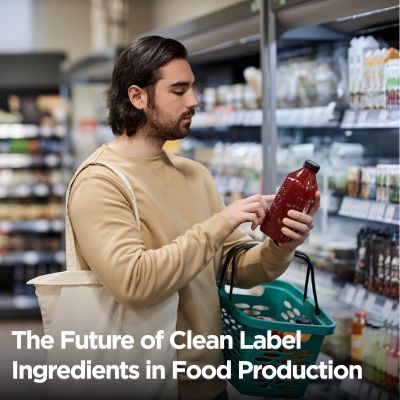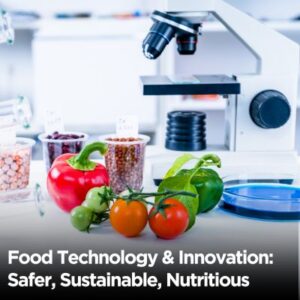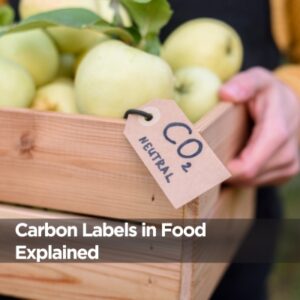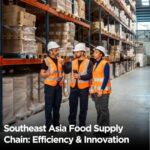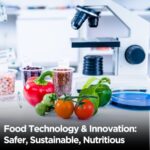The future of clean-label ingredients is a significant priority in food production. Clean label refers to the use of simple and familiar ingredients, excluding artificial additives, preservatives, and synthetic chemicals.
These ingredients, such as flour, salt, or lemon juice, are easier to recognize than processed or chemical-based substances.
Today’s consumers are more mindful of what’s in their food. They’re reading labels closely and favoring products with short, clear ingredient lists. Shoppers tend to avoid anything that sounds overly technical or unfamiliar.
As a result, many food manufacturers are moving away from artificial ingredients and opting for natural alternatives. Clean label products are now widely available across multiple categories, including snacks, drinks, condiments, and ready-made meals.
To meet this demand, companies are reformulating recipes, sourcing cleaner ingredients, and clearly communicating product details. Clean label is no longer a trend, but a standard that influences the development and marketing of food products.
The Rising Trend of Clean Labels in Food Production
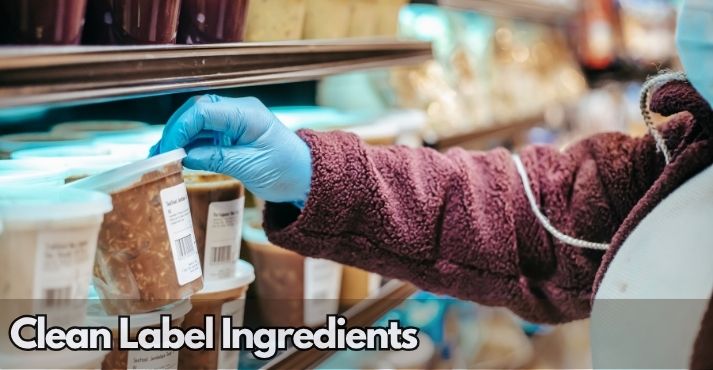
Consumers are choosing products with clean, simple ingredients more often than before. This demand stems from a stronger focus on health and well-being, as many people want to avoid artificial additives and preservatives.
Concerns about the long-term effects of synthetic chemicals in food have led shoppers to become more selective. They seek natural and trustworthy products, leading food producers to make changes.
The rise of health-conscious lifestyles, including interest in whole foods and natural diets, supports this move toward clean labels. Consumers expect transparency and prefer foods made from recognizable ingredients.
Research indicates that 81% of shoppers consider purchasing clean-label food products to be necessary. As a result, companies are paying close attention to clean label trends to meet customer expectations.
The market is expanding yearly as more brands focus on sourcing the right suppliers and developing products that meet clean label standards.
Market Growth and Consumer Preferences for Clean Labels
The demand for clean label products is influencing many aspects of the food industry. As consumers focus more on what goes into their food, the market for clean label ingredients is expanding rapidly.
This change affects not only product development but also sourcing and marketing strategies.
Market Growth in Clean Label Ingredients
The global clean label ingredients market was valued at $20.9 billion in 2021. Projections indicate it could reach $44.46 billion by 2030, with an annual growth rate of approximately 8.9% expected between 2022 and 2030.
This steady increase shows that clean labels are expanding from niche markets to become a significant part of the food industry.
Many companies are adopting sustainable sourcing practices to meet the demand for natural and responsibly produced ingredients.
The growing clean label food products sector covers a wide range, from snacks and beverages to packaged meals, demonstrating the widespread impact clean label ingredients have today.
Consumer Demand and Health Consciousness
Consumers seek healthier food options perceived as natural and minimally processed. Clean label products offer the transparency shoppers want by providing simple, recognizable ingredient lists without artificial additives. This transparency has a significant impact on consumer purchasing decisions.
The food service industry is also responding by incorporating clean label ingredients into menu offerings. Customers expect the same ingredient clarity and quality in prepared meals as in packaged goods, pushing food providers to align with these preferences.
Clean Label Demand Across Generations
Clean label trends appeal strongly to different generations, especially Millennials and Gen Z. Studies indicate that 80% of Millennials and 72% of Gen Z consumers prioritize purchasing products with clean labels.
These generations value health, sustainability, and ethical production, which influence their food choices.
This focus leads brands to prioritize sustainable sourcing and responsible ingredient selection. The values of younger consumers are influencing industry practices and encouraging greater transparency and accountability.
Benefits of Clean Label Ingredients in Food Production

Clean label ingredients are becoming more common in food production as consumers seek clearer, healthier, and more sustainable options.
These ingredients offer multiple advantages for both consumers and producers, including increased trust, improved health outcomes, and more eco-friendly practices.
1. Enhanced Trust and Transparency
Clean label ingredients for consumers mean more than just recognizable names on packaging. They represent a commitment to transparency that builds trust between brands and their customers.
When companies openly share information about ingredient sourcing and production methods, it builds consumer confidence and loyalty.
This transparency is crucial in the food and beverage industry, where consumers are increasingly scrutinizing labels for clarity and honesty. By providing straightforward information, brands can enhance the guest journey, ensuring that customers feel informed and valued.
2. Addressing Consumer Health Concerns
Using clean label ingredients helps address concerns about artificial additives, preservatives, and allergens. Consumers are seeking products that are free from synthetic chemicals, aiming to minimize potential health risks and promote overall well-being.
By removing unnecessary additives, clean label products can reduce the risk of foodborne illnesses and allergic reactions. This aligns with the preferences of consumers who prioritize natural and minimally processed foods.
3. Environmental Benefits
Clean label ingredients often support sustainable food practices, such as sourcing locally and minimizing waste in food production.
By focusing on natural and minimally processed ingredients, companies can reduce environmental impact and support a more sustainable future.
These eco-friendly production processes not only benefit the planet but also resonate with consumers who value environmental responsibility. Brands that focus on sustainability and offer clean label products can enhance their market position and attract more customers.
Clean Label Ingredients and the Food Production Process
Food producers are changing how they make products to meet demand for clean label ingredients. They need to remove artificial additives but still keep the food tasting good and lasting on shelves.
At the same time, finding ingredients that are sustainable and sourced is becoming more important. However, there are challenges in making these changes happen quickly.
Reformulation and Innovation in Clean Label Products
Food makers are finding new ways to replace artificial ingredients with natural ones while keeping the right taste and texture.
It can be challenging to maintain the product’s freshness and enjoyment without using synthetic additives. This requires testing new recipes and ingredients carefully.
Sourcing Clean Ingredients
More companies are opting for ingredients from suppliers that offer sustainable, clean-label options, such as non-GMO or organic ingredients.
These suppliers are adjusting to meet the needs of food producers and the restaurant industry, where health-conscious food labeling is a priority.
Overcoming Challenges in Clean Label Adoption
Switching to sustainable, clean label ingredients can be costly and complicated. Sometimes ingredients are hard to get or more expensive. It also takes time and research to develop high-quality, clean-label recipes.
These challenges mean clean label products can take longer to appear on shelves, but companies are working through them step by step.
The Future of Clean Labels in Food Production
Clean labels are becoming a standard feature of how food is produced and marketed. As people continue to seek simple, honest ingredients, the food industry is making steady adjustments to keep up with the demand.
What comes next will depend on the development of new tools, changing consumer preferences, and updates to food labeling regulations.
Emerging Trends in Clean Label Ingredients
Plant-based clean label products, natural sweeteners, and organic items are becoming more common. Many consumers want simple foods without synthetic additives, and brands are finding ways to deliver that.
New ingredient research and processing methods are helping food makers keep taste and shelf life while simplifying labels.
This change is also being noticed in the restaurant industry, where chefs and operators aim to offer meals with recognizable ingredients and fewer chemicals.
Predictions for the Next Decade
Over the next several years, clean labels may include more than just ingredients. Shoppers may look for details about how a product was made and where it originated.
This demand for complete clarity could lead to cleaner menus and more transparent packaging throughout the industry.
In full-service restaurants, clear ingredient lists and cleaner meal options help build stronger trust with diners.
As health and sustainability stay top of mind, the future of food labeling will focus more on proof through sourcing, certifications, and traceable production.
Regulatory Changes and Their Impact
New rules may soon define what clean label really means. Governments are already discussing stronger guidelines around ingredient terms, especially when it comes to words like “natural” or “healthy.”
Stricter standards require clearer sourcing and labeling, which could slow some product launches but help reduce confusion. For brands seeking clean label certifications in food, this may involve revising ingredient lists and packaging to meet legal requirements.
How Food Companies Can Capitalize on Clean Label Trends
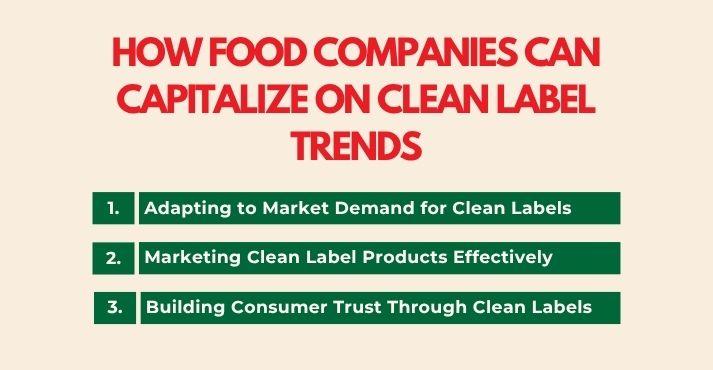
Clean label practices offer food companies an opportunity to establish stronger connections with customers and provide products that align with current expectations.
Clear ingredient lists, better sourcing, and honest communication can help brands earn trust and stay competitive.
Adapting to Market Demand for Clean Labels
Food businesses looking to transition to or expand their clean label offerings should begin by reviewing their current ingredient lists and identifying synthetic additives or preservatives that can be replaced.
Reformulating recipes requires careful testing to preserve taste, texture, and shelf life without using artificial components.
Companies can benefit from working with suppliers that provide traceable, verified ingredients, including non-GMO, organic, or locally sourced options. This supports consistent product quality and meets expectations for health-conscious food labeling.
It’s also important to maintain clear documentation during this process to meet current regulatory requirements and growing consumer expectations.
Marketing Clean Label Products Effectively
To connect with customers, food companies should highlight their clean label commitments through packaging, advertising, and digital channels.
Emphasizing the health benefits of simpler ingredients, along with sustainable clean label ingredients, can help brands reach a wider audience.
Transparency in messaging, such as explaining why specific ingredients are used, can increase consumer confidence. Third-party certifications, such as USDA Organic or Non-GMO Project Verified, also add credibility.
Brands can strengthen their message by connecting clean label efforts to values such as wellness and environmental responsibility, particularly in industries like the restaurant sector.
Building Consumer Trust Through Clean Labels
Consumer trust is built when businesses communicate what’s in their products and why. Using recognizable ingredients, offering sourcing details, and labeling clearly are essential first steps.
Displaying clean label certifications in food packaging and menus can reassure consumers and demonstrate accountability.
Additionally, eco-friendly packaging choices, such as those made from compostable materials or those with reduced plastic use, can reinforce a company’s broader sustainability efforts.
Highlighting these initiatives in-store and online helps customers see the full picture, from ingredients to packaging, and supports long-term brand loyalty.
Conclusion
Clean labels are now essential in the food industry as consumers want simple, natural ingredients and clear information. Concerns about health and artificial additives make clean label ingredients essential for building trust and supporting sustainable practices.
Although reformulating products and sourcing clean ingredients can be challenging, these efforts help businesses meet customer needs.
Looking ahead, clean labels will become increasingly important as people prioritize transparency and healthier choices.
Companies that use clean label ingredients can build stronger customer loyalty, stand out from competitors, and promote a more sustainable food system.
Clean labels will influence how food is produced and marketed, creating opportunities for innovation and growth.

